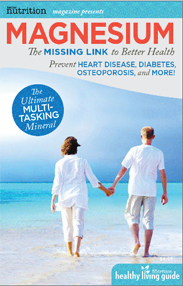Magnesium Supplements are as Vital as Calcium for Preventing and Treating Osteoporosis
 There are approximately eighteen nutrients essential for healthy bones, including magnesium, the most important mineral after calcium.
There are approximately eighteen nutrients essential for healthy bones, including magnesium, the most important mineral after calcium.
Susan Brown, Ph.D., director of the Osteoporosis Education Project in Syracuse, New York, warns that œthe use of calcium supplementation in the face of magnesium deficiency can lead to a deposition of calcium in the soft tissue such as the joints, promoting arthritis, or in the kidney, contributing to kidney stones.
Dr. Brown recommends a daily dose of only 450 mg of magnesium for the prevention and treatment of osteoporosis.
Women with osteoporosis have lower-than-average levels of magnesium in their diets, according to survey reports. Magnesium deficiency can compromise calcium metabolism and also hinder the body’s production of vitamin D, further weakening bones.
Magnesium’s Role in Bone Health is Multifaceted
Adequate levels of magnesium are essential for the absorption and metabolism of calcium.
Magnesium stimulates a particular hormone, calcitonin, that helps to preserve bone structure and draws calcium out of the blood and soft tissues back into the bones, preventing some forms of arthritis and kidney stones.
Magnesium suppresses another bone hormone called parathyroid, preventing it from breaking down bone.
Magnesium converts vitamin D into its active form so that it can help calcium absorption.
Magnesium is required to activate an enzyme that is necessary to form new bone.
Magnesium regulates active calcium transport.
With all these roles for magnesium to play, it is no wonder that even a mild deficiency can be a risk factor for osteoporosis. Further, if there is too much calcium in the body, especially from calcium supplementation, magnesium absorption can be greatly impaired, resulting in worsening osteoporosis and the likelihood of kidney stones, arthritis, and heart disease. Excess calcium can also deposit in cancerous tumors worsening this condition.
It is unfortunate that the treatment for osteoporosis has been simplified into the single battle cry “Take calcium”. Calcium dominates every discussion about osteoporosis, is used to fortify dozens of foods (including orange juice and cereal), and is a top-selling supplement, but it cannot stand alone.
Calcium and magnesium work so closely together that the lack of one immediately diminishes the effectiveness of the other. Even though the use of calcium supplementation for the management of osteoporosis has increased significantly in the last decade, scientific studies do not support such large doses after menopause. Soft tissue calcification could be a serious side effect of taking too much calcium. 2
References:
1. Brown S, Better Bones, Better Body, Keats Publishing, New Canaan, CT, 1996.
2. Brown S, Better Bones, Better Body, Keats Publishing, New Canaan, CT, 1996.
Newsletter
![]()

Want valuable information regarding the health benefits of magnesium, latest studies, expert interviews,videos and health tips? Enter your name and email address and you can start receiving valuable health information right away.
Featured On:








